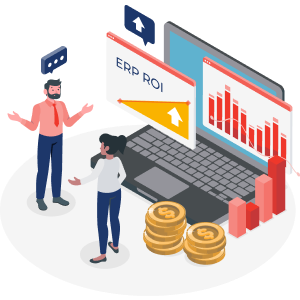Enterprise Resource Planning (ERP) systems are the backbone of modern businesses, streamlining operations, improving efficiency, and enhancing decision-making processes. Among the three common types of ERP systems - cloud-based, on-premises, and hybrid - each has its unique advantages and best-fit scenarios. In this comprehensive guide, we'll delve into these three ERP categories, offering insights and real-world examples to help you make an informed choice for your business.
Part 1: Understanding Cloud-Based ERP Systems
Cloud-Based ERP: A Game Changer
Cloud-based ERP systems operate on third-party, remote servers, providing businesses with flexibility, scalability, and cost-effectiveness. They eliminate the need for in-house IT infrastructure, reducing upfront costs and IT staff requirements. Data stored in the cloud ensures real-time access from anywhere, catering to today's mobile-first world.

Real-World Benefits: Case Studies
ToughBuilt Industries Inc.: By utilizing Acumatica's cloud-based ERP, ToughBuilt Industries achieved remarkable efficiency and reliability. The mobile app feature enabled on-the-go operations, showcasing the system's flexibility and ease of use.
SAM (Case Study): SAM, an Acumatica Cloud ERP user, exemplifies the system's effectiveness in managing the quote-to-cash cycle. Real-time dashboards enable informed decision-making, even outside the office, revolutionizing business operations.
J. Goodin: J. Goodin, a fashion jewelry manufacturer, leveraged Acumatica to automate global sales processes. The cloud-based nature of Acumatica facilitated quick order processing and offered a growth-based pricing model, enabling international scalability.
Key Takeaway
Cloud-based ERP systems are ideal for businesses aiming to streamline operations and expand globally. The flexibility, scalability, and accessibility they offer lead to operational efficiency, improved financial management, and enhanced decision-making capabilities.
Part 2: Understanding On-Premises ERP Systems
On-Premises ERP: The Traditional Approach
On-premises ERP systems are installed and run on a company's servers and infrastructure, providing complete control over the ERP environment and data. However, they come with responsibilities such as hardware maintenance, software updates, and data security.

Real-World Challenges: Case Studies
Erickson International LLC: Erickson faced challenges with its on-premises ERP system. The legacy manufacturing module proved difficult to implement and ran slowly, leading to manual data handling and inefficiency. They sought a modern, cloud-accessible ERP solution for better inventory transparency and operational efficiency.
Ergoresearch Ltd.: In the healthcare and orthotics industry, Ergoresearch's on-premise ERP system couldn't keep up with rapid growth and consolidation needs across multiple sites. They switched to a web-based ERP solution to accommodate expansion and integration.
Frederick Block Brick & Stone (FBBS): FBBS operated on a standalone on-premises ERP for years, resulting in labor-intensive manual data handling and limited accessibility. They faced difficulties in reporting for multiple locations, highlighting the limitations of traditional on-premises ERP systems.
Key Takeaway
While on-premises ERP systems offer control and customization, they can also pose challenges in terms of flexibility, scalability, and remote accessibility. Companies often have to weigh the trade-offs between the control provided by an on-premises system and the agility of cloud-based solutions.
As seen in the case studies, companies might start with on-premises ERPs but eventually move towards more modern solutions to meet growing needs and ensure efficient operations.
In the final part, we will explore hybrid ERP systems, which combine elements of both on-premises and cloud-based systems, offering a balanced approach for many businesses.
Do you want to get a deeper dive into the comparison of cloud and on-premise ERP systems?
Read our article “Why Cloud ERP is a Better Choice over a Traditional One”
Part 3: Understanding Hybrid ERP Systems
Hybrid ERP systems blend elements of both on-premises and cloud-based ERP solutions. They offer the security and control of on-premises systems with the flexibility and scalability of cloud services. This approach is beneficial for businesses that need to maintain some of their operations on-premises for regulatory or operational reasons, while also taking advantage of the cloud's benefits.
Hybrid ERP: The Best of Both Worlds
Hybrid ERP systems are designed to cater to businesses that have diverse operational needs or are in transition phases. For instance, a company might use an on-premises ERP for its core operations while leveraging cloud-based modules for specific functions like CRM, HR, or sales.

Real-World Examples: Case Studies
J. Goodin: Initially, J. Goodin used a traditional ERP software, which required remote desktop solutions for access. As the business expanded, they switched to NetSuite, a cloud solution, but faced issues with performance and support. Eventually, they opted for Acumatica, balancing the need for a reliable, cloud-based system that could support various sales models and business processes. This move highlights the transition from a traditional to a more hybrid approach to meet evolving business needs.
Erickson International LLC: Erickson’s journey reflects a shift towards hybrid ERP. They initially had on-premises servers running a legacy manufacturing module, which proved inefficient. The CFO sought a more modern solution that provided cloud-based access and better inventory transparency, demonstrating a move towards a hybrid model for greater efficiency and scalability.
Cottingham Ltd.: This company recognized the need for a new ERP system, especially one based in the cloud, when they decided to run their business using Apple’s OS instead of Windows. They chose Acumatica for its cloud accessibility, affordability, and support, moving away from traditional ERP systems like Sage ERP Accpac and SAP Business One. This transition illustrates the shift towards a hybrid model, blending traditional and cloud-based functionalities.
Key Takeaway
Hybrid ERP systems represent a strategic approach for businesses seeking to balance robust, secure on-premises solutions with the agility and scalability of cloud applications. Companies can tailor their ERP environment to specific operational needs and growth plans, ensuring both stability and flexibility in their business processes.
In conclusion, understanding the differences between cloud-based, on-premises, and hybrid ERP systems is crucial for selecting the right solution that aligns with your business's specific requirements and goals. Each type offers distinct advantages, and the choice depends on your unique operational needs and growth aspirations.
If you need more information and a demonstration of an ERP system, Acumatica specifically, we invite you to book a call with our certified ERP consultant.
You can ask us any questions or express concerns about the ERP system (if you have any).
AcuPower LTD - Your Perfect ERP Vendor for Your Growing Business
AcuPower LTD is a team of Acumatica ERP experts and an Acumatica partner.
You can reach out to our AcuPower team if you need:
- Consultations;
- Acumatica training;
- Acumatica ERP implementation;
- Acumatica development services;
- Customizations of your ERP software;
- Custom quotes on Acumatica licensing;
- Acumatica upgrade or support of old versions;
- Development of new Acumatica modules and their certification;
- Custom tracking tools, reports, or solutions (QA testing included);
With our advanced knowledge and skills, you can create any solution you need, automate business operations, work more efficiently, scale your business, and thrive.
If you are looking for an ERP vendor who offers all services under one roof (which is cost-efficient for you), our AcuPower team is your perfect choice.
➡️ Learn more about Acumatica;
➡️ How much is Acumatica Cloud ERP?
Comments (0)
No comments yet
Be the first to comment
 Share on Facebook
Share on Facebook
 Share on LinkedIn
Share on LinkedIn
 Share on Twitter
Share on Twitter















 1709
1709




